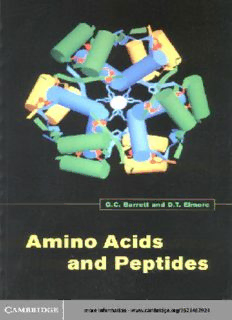
Amino Acids and Peptides PDF
Preview Amino Acids and Peptides
The authors’ objective has been to concentrate on amino acids and pep- tides without detailed discussions of proteins, although the book gives all the essential background chemistry, including sequence determination, synthesis and spectroscopic methods, to allow the reader to appreciate protein behaviour at the molecular level. The approach is intended to encourage the reader to cross classical boundaries, such as in the later chapter on the biological roles of amino acids and the design of peptide- based drugs. For example, there is a section on enzyme-catalysed synthesis of peptides, an area often neglected in texts describing peptide synthesis. This modern text will be of value to advanced undergraduates, graduate students and research workers in the amino acid, peptide and protein field. Amino Acids and Peptides Amino Acids and Peptides G. C.IBARRETT D. T. ELMORE The Pitt Building, Trumpington Street, Cambridge, United Kingdom The Edinburgh Building, Cambridge CB2 2RU, UK 40 West 20th Street, New York, NY 10011-4211, USA 477 Williamstown Road, Port Melbourne, VIC 3207, Australia Ruiz de Alarcón 13, 28014 Madrid, Spain Dock House, The Waterfront, Cape Town 8001, South Africa http://www.cambridge.org ©Cambridge University Press 2004 First published in printed format 1998 ISBN 0-511-03952-2 eBook (netLibrary) ISBN 0-521-46292-4 hardback ISBN 0-521-46827-2 paperback Contents Foreword page xiii 1 Introduction 1 1.1 Sources and roles of amino acids and peptides 1 1.2 Definitions 1 1.3 ‘Protein amino acids’, alias ‘the coded amino acids’ 3 1.4 Nomenclature for ‘the protein amino acids’, alias ‘the coded amino acids’ 7 1.5 Abbreviations for names of amino acids and the use of these abbreviations to give names to polypeptides 7 1.6 Post-translational processing: modification of amino-acid residues within polypeptides 11 1.7 Post-translational processing: in vivo cleavages of the amide backbone of polypeptides 11 1.8 ‘Non-protein amino acids’, alias ‘non-proteinogenic amino acids’ or ‘non-coded amino acids’ 11 1.9 Coded amino acids, non-natural amino acids and peptides in nutrition and food science and in human physiology 13 1.10 The geological and extra-terrestrial distribution of amino acids 15 1.11 Amino acids in archaeology and in forensic science 15 1.12 Roles for amino acids in chemistry and in the life sciences 16 1.12.1 Amino acids in chemistry 16 1.12.2 Amino acids in the life sciences 16 1.13 (cid:1)- and higher amino acids 17 1.14 References 19 2 Conformations ofamino acids and peptides 20 2.1 Introduction: the main conformational features of amino acids and peptides 20 vii Contents 2.2 Configurational isomerism within the peptide bond 20 2.3 Dipeptides 26 2.4 Cyclic oligopeptides 26 2.5 Acyclic oligopeptides 27 2.6 Longer oligopeptides: primary, secondary and tertiary structure 27 2.7 Polypeptides and proteins: quaternary structure and aggregation 28 2.8 Examples of conformational behaviour; ordered and disordered states and transitions between them 29 2.8.1 The main categories of polypeptide conformation 29 2.8.1.1 One extreme situation 29 2.8.1.2 The other extreme situation 29 2.8.1.3 The general case 29 2.9 Conformational transitions for amino acids and peptides 30 2.10 References 31 3 Physicochemical properties ofamino acids and peptides 32 3.1 Acid–base properties 32 3.2 Metal-binding properties of amino acids and peptides 34 3.3 An introduction to the routine aspects and the specialised aspects of the spectra of amino acids and peptides 35 3.4 Infrared (IR) spectrometry 36 3.5 General aspects of ultraviolet (UV) spectrometry, circular dichroism (CD) and UVfluorescence spectrometry 37 3.6 Circular dichroism 38 3.7 Nuclear magnetic resonance (NMR) spectroscopy 41 3.8 Examples of assignments of structures to peptides from NMR spectra and other data 43 3.9 References 46 4 Reactions and analytical methods for amino acids and peptides 48 Part 1 Reactions of amino acids and peptides 48 4.1 Introduction 48 4.2 General survey 48 4.2.1 Pyrolysis of amino acids and peptides 49 4.2.2 Reactions of the amino group 49 4.2.3 Reactions of the carboxy group 49 4.2.4 Reactions involving both amino and carboxy groups 51 4.3 A more detailed survey of reactions of the amino group 51 4.3.1 N-Acylation 51 4.3.2 Reactions with aldehydes 52 4.3.3 N-Alkylation 53 viii Contents 4.4 A survey of reactions of the carboxy group 53 4.4.1 Esterification 54 4.4.2 Oxidative decarboxylation 54 4.4.3 Reduction 54 4.4.4 Halogenation 55 4.4.5 Reactions involving amino and carboxy groups of (cid:2)-amino acids and their N-acyl derivatives 55 4.4.6 Reactions at the (cid:2)-carbon atom and racemisation of (cid:2)-amino acids 55 4.4.7 Reactions of the amide group in acylamino acids and peptides 57 4.5 Derivatisation of amino acids for analysis 58 4.5.1 Preparation of N-acylamino acid esters and similar derivatives for analysis 58 4.6 References 60 Part 2 Mass spectrometry in amino-acid and peptide analysis and in peptide-sequence determination 61 4.7 General considerations 61 4.7.1 Mass spectra of free amino acids 61 4.7.2 Mass spectra of free peptides 62 4.7.3 Negative-ion mass spectrometry 65 4.8 Examples of mass spectra of peptides 65 4.8.1 Electron-impact mass spectra (EIMS) of peptide derivatives 65 4.8.2 Finer details of mass spectra of peptides 68 4.8.3 Difficulties and ambiguities 69 4.9 The general status of mass spectrometry in peptide analysis 69 4.9.1 Specific advantages of mass spectrometry in peptide sequencing 70 4.10 Early methodology: peptide derivatisation 71 4.10.1 N-Terminal acylation and C-terminal esterification 71 4.10.2 N-Acylation and N-alkylation of the peptide bond 72 4.10.3 Reduction of peptides to ‘polyamino-polyalcohols’ 72 4.11 Current methodology: sequencing by partial acid hydrolysis, followed by direct MS analysis of peptide hydrolysates 72 4.11.1 Current methodology: instrumental variations 74 4.12 Conclusions 77 4.13 References 77 ix
Description: